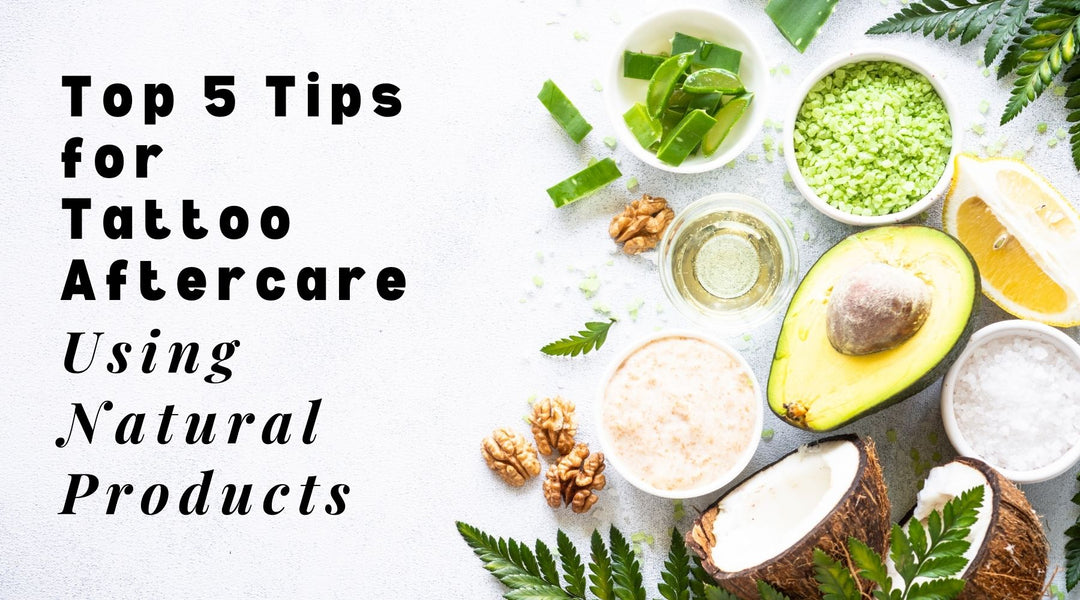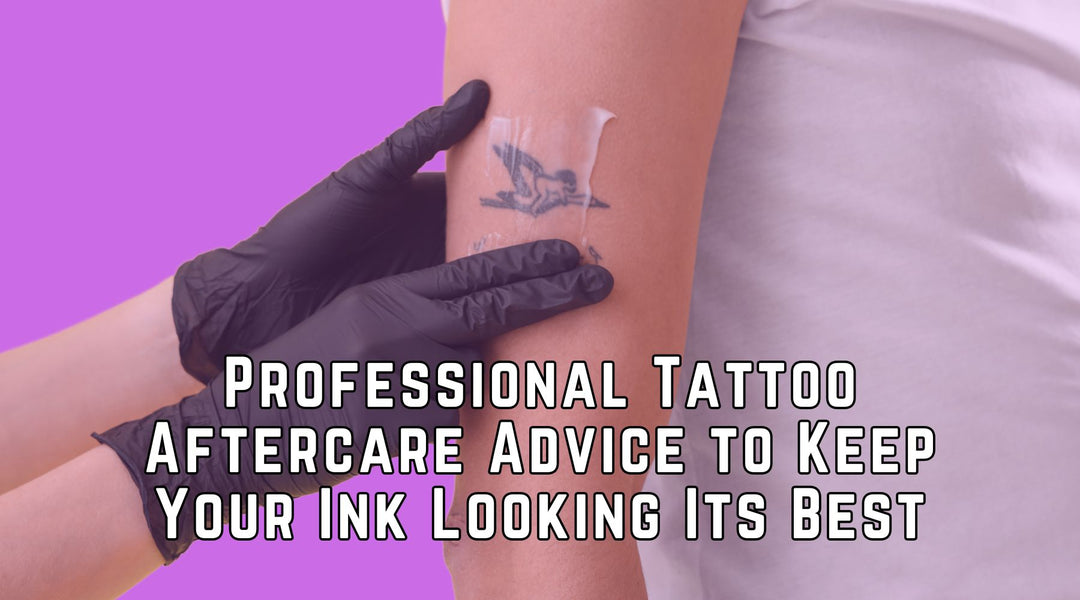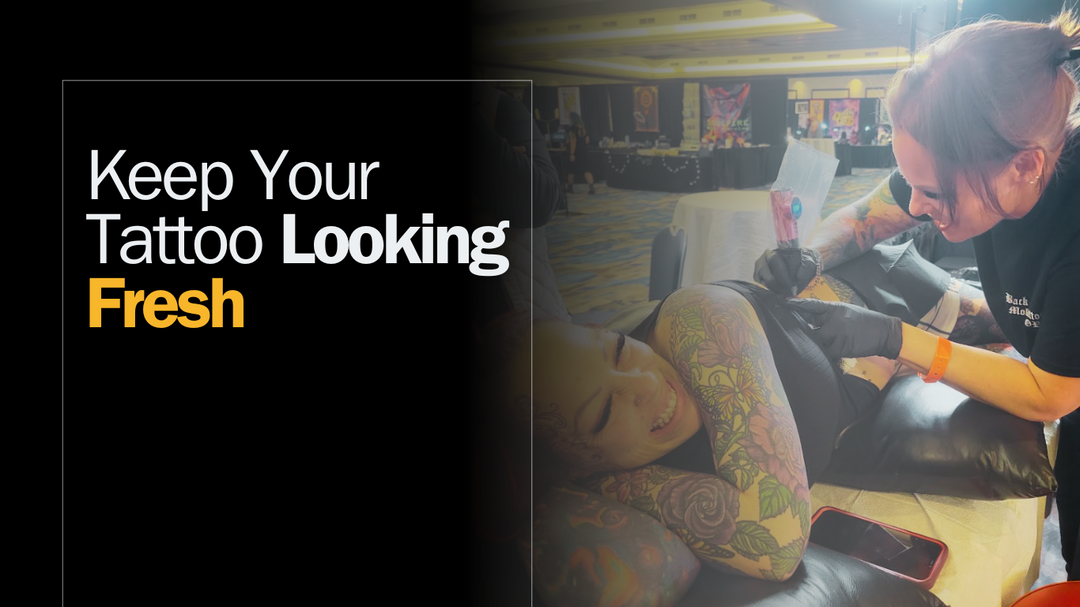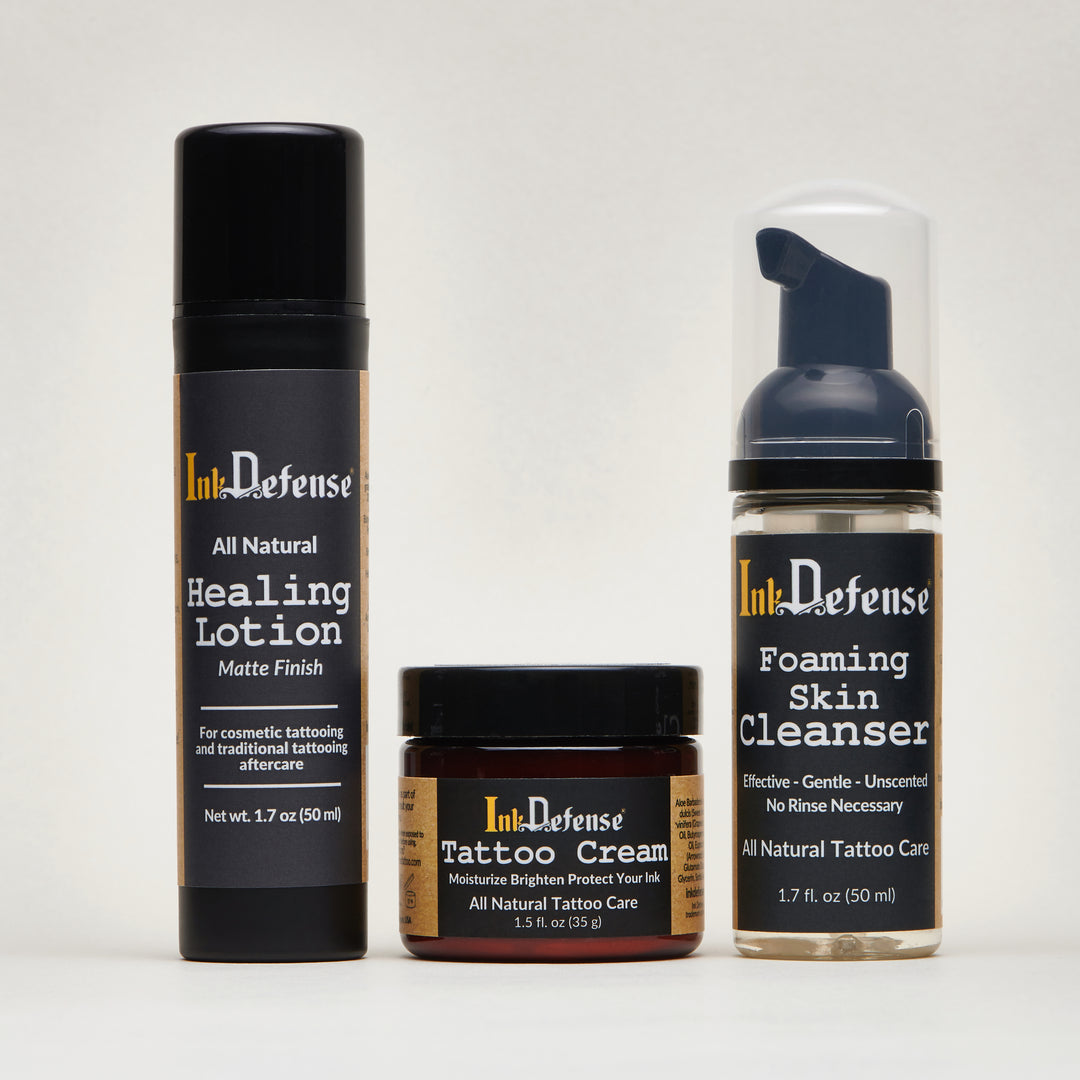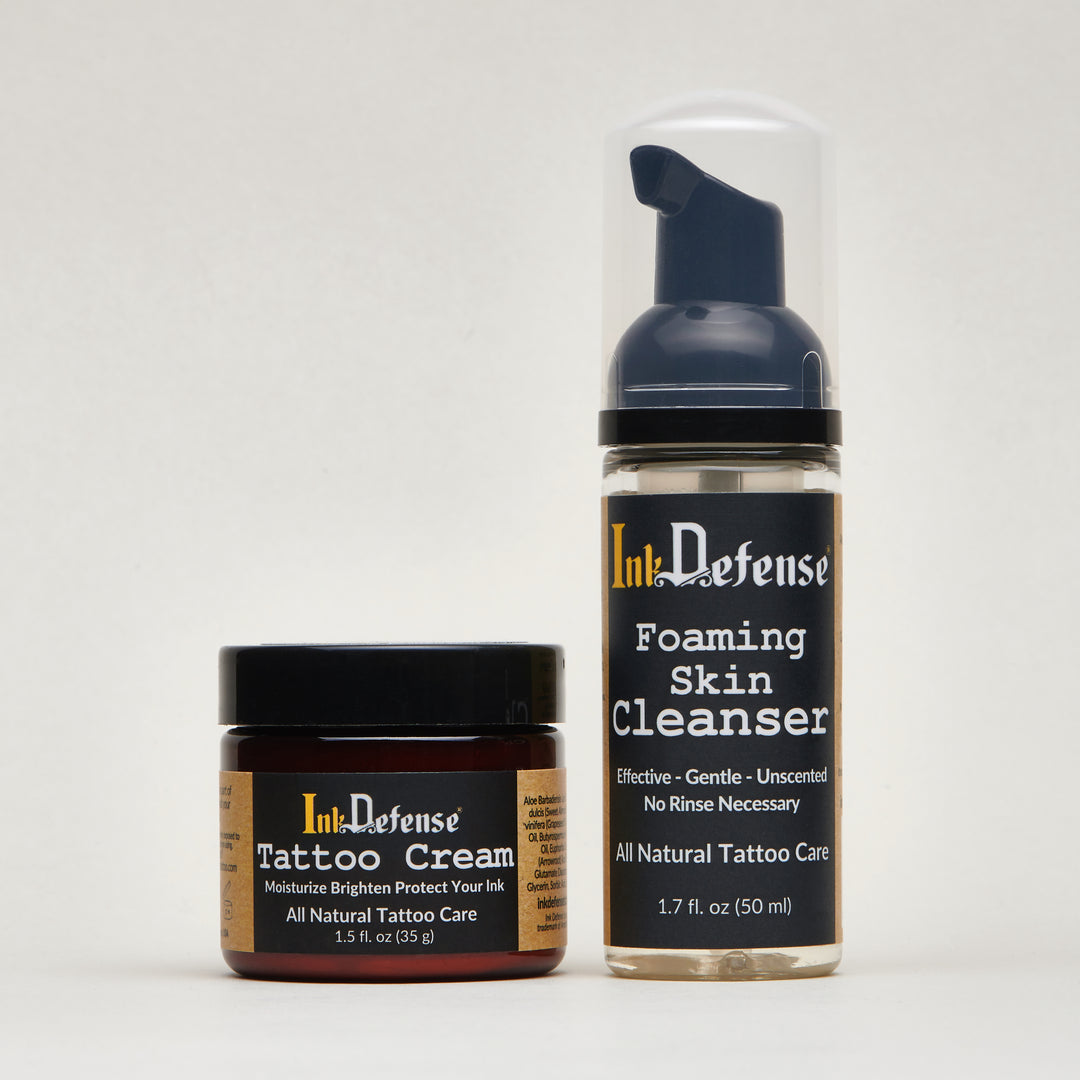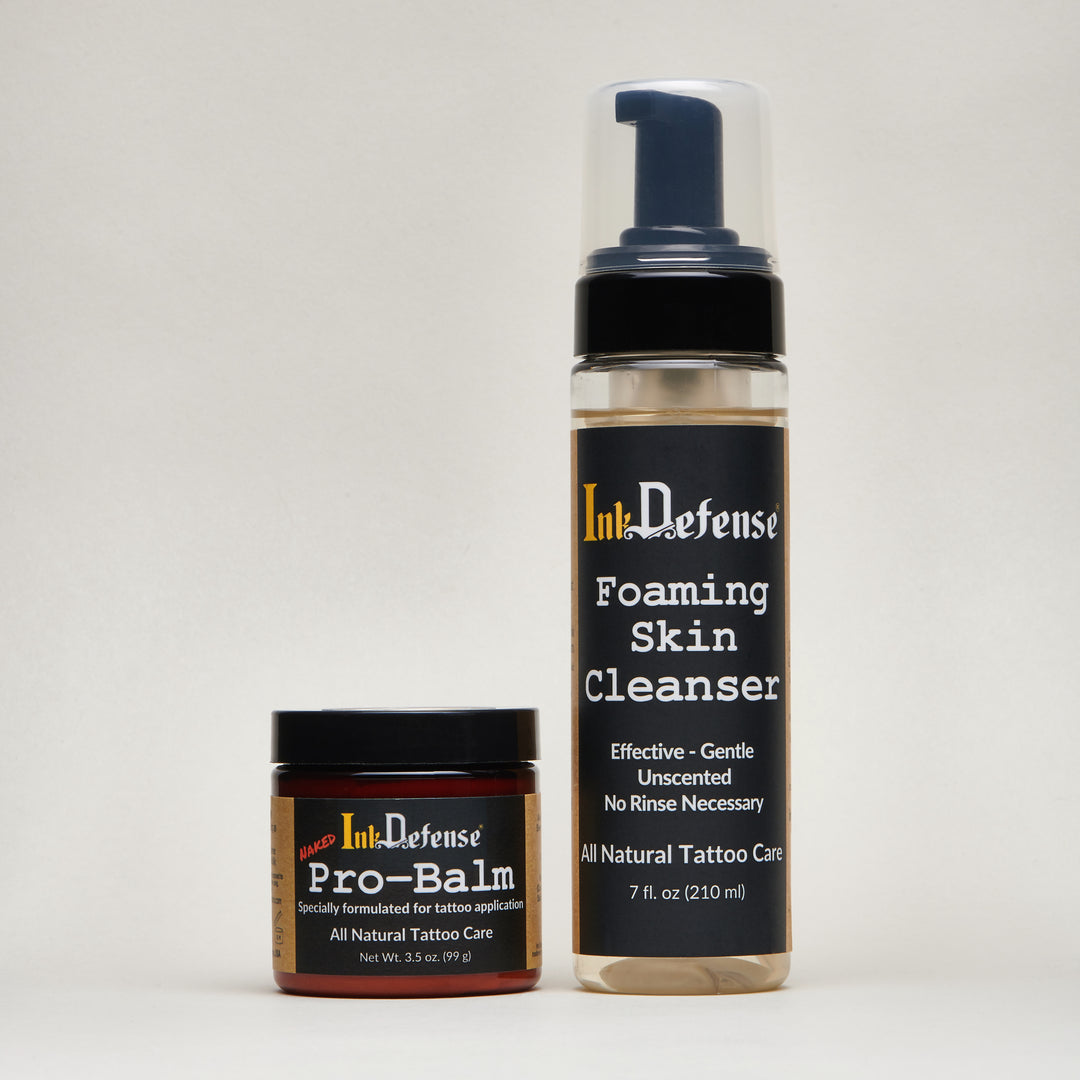Tattoo Aftercare-Ultimate guide with tips and daily routines
Whether it's your first tattoo or you are adding to a current tattoo, your tattoo aftercare will have an incredible impact on the longevity and quality of your tattoos. To avoid scarring, discoloration, and long term distortion follow proper tattoo aftercare. From day one to long into the sunset, the information here will help you learn how to protect and defend your ink against it all.
In this article
Why Is Tattoo Aftercare Important?
Tattoo Aftercare Guide Day-By-Day
Types of Tattoo Aftercare Products
The Don'ts of Tattoo Aftercare
Signs To See Your Doctor
After the Initial Tattoo Aftercare - Long Term Care
FAQ’s about tattoo aftercare
Why Is Tattoo Aftercare Important?
Tattoo aftercare...the steps you take to protect the look of your new tattoo and prevent side effects, such as infection. Tattoo aftercare is important to safely heal and maintain the look of your body art.
How you treat your new tattoo can directly impact how it will age. It all starts with tattoo aftercare. The size, ink saturation, and tattoo placement can all have an impact on how your tattoo heals. The deeper and greater the trauma to the skin, the longer it can take to heal.
How long do you want your tattoo to look fresh, accurate, and fresh? How you take care of your tattoo from day one makes a huge difference to how your tattoo looks in ten years.
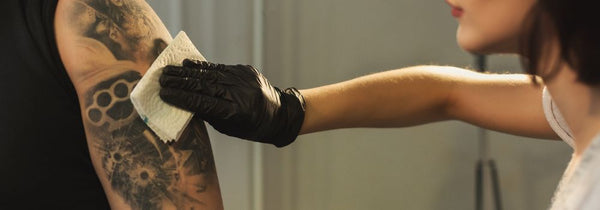
Aftercare Guide: Day-By-Day
While the size and placement can impact the tattoo healing process - the more delicate tattoos can also slow the healing process. Swollen, scabbing skin can be difficult to keep clean on highly intricate tattoo designs. Be gentle, take your time to cleanse the entire tattoo, don’t scratch or pick at it - but allow skin to naturally slough off as it heals.
Day of Tattoo
Great aftercare starts the day of your tattoo. You want to be hydrated, nourished, and sober when getting fresh ink. A reputable, licensed tattoo artist will talk you through your tattoo aftercare instructions. When your finished tattoo is dressed, your artist will go over removal instructions and may recommend products specifically designed to clean, protect, and heal tattooed skin. More about these later.
With this initial wrap removal, take the opportunity to clean the sensitive skin. Use a tattoo safe aftercare soap to cleanse the entire area. Rinse well with lukewarm water and carefully pat dry. Consider the instructions your tattoo artist gave you about moisturizer and protection.
Quick Tip: Use clean towels and sheets. Keep them freshly washed to prevent contamination. Avoid sharing and opt for gentle materials. Change them regularly for cleanliness. Clean towels and sheets promote proper healing and prevent infections.
Days 2 to 5
As your tattoo heals, it will appear thick and cloudy and start to scab. Do not pick or scratch at the dry skin, as this can cause permanent damage to your tattoo. It is normal for ink to come up through your skin and you may see some ink when you clean and rinse your fresh tattoo. During these first few days, continue gently washing, rinse, pat dry, and protect your tattoo.
Days 6 to 14
As you move into the second week of your tattoo healing, you should have seen any signs of infection or problems. Scabbing should be flaking off naturally. Redness, soreness, and swelling should be gone by now. It is normal for skin to feel itchy as it heals. Consider the tattoo aftercare products available and mentioned below to find the right product for your skin and ink.
Days 15 to 30
This is the last stage of healing and you should no longer see scabbing, dry patches, redness, swelling, or other discoloration. Some dullness and dryness is normal. A good quality tattoo aftercare skincare product is the perfect solution and will help protect your tattoo over long term use.
It could take 3-4 weeks for complete healing of your new tattoo. The most important part of healing your fresh ink is hydration and cleanliness. When you take the time to keep your fresh ink clean and hydrated, you are honoring the artist's work.
Types of Tattoo Aftercare Products
The world of tattoo aftercare products is growing, but as with any new skin care product, safety is essential when it comes to tattoo aftercare products. With anything you put on your skin, you want it to be clean, hydrating, safe, and made with quality ingredients.
Tattoo Aftercare Wrap
There are two main types of tattoo aftercare wrap used in the industry. These include household plastic wrap or what you might find in the kitchen (generally left on for the first 2 - 4 hours) or medical-grade, breathable, waterproof tattoo bandage that is adhesive based and applied by the tattoo artist at the end of your session.
Be open to ask your tattoo artist what tattoo aftercare wraps and types of tattoo aftercare products to use to protect your fresh ink. While an initial wrap will be recommended until initial bleeding has stopped, many tattoo artists will recommend you wrap your new tattoo for at least 24 hours.
Be aware of a possible allergic reaction to the wrap adhesive. If you notice this happening, carefully remove your wrap immediately with clean hands. There are two main reasons for an aftercare wrap: you want to protect your new tattoo from bacteria and it’s important to protect your fresh ink from clothing, the sun, and other environmental contaminants.
Soap
When considering the types of soaps to use to clean your fresh ink, it’s important that it not only cleanses bacteria, but also does not cause an allergic reaction to fragrance or other additives. Many soaps, including antibacterial soaps, may say they are clean and can be promoted as all-natural. Make sure it is unscented and free from irritants. Always check the ingredients for products allergens and other synthetic ingredients that may be in the product formulation.
Moisturizers
While there are a variety of products to choose from, any product used for moisturizing your tattoo should be fragrance or perfume free and not contain dyes or petroleum products.
Avoid petroleum-based products as they tend to be too thick and can suffocate the tattoo, hindering the healing process. This type of occlusive ointment can trap germs and damage your tattoo. Scented body lotion is not a substitute for a moisturising product formulated specifically for tattoo healing.
Check the product label for any ingredients you might be sensitive to and to ensure you will not have an adverse reaction. Look for clean and natural products designed for tattoo healing.
Lotions and creams are more spreadable than ointments. It is important to apply a thin layer of moisturizer on your tattoo to let the pores of your skin breathe. It is your preference if a lotion, cream, or ointment is chosen, as long as the ingredients promote healthy healing of your tattoo.
Sunscreen
A little talked about and available product is sunscreens specifically formulated to protect your tattoos against the sun.
As with all skin care, sunscreen is an important product to protect against aging and sun damage, which can include dark spots, wrinkles, and crepey skin. UV rays destroy and damage the collagen, which leads to fading of your tattoo. If you can’t keep your tattoo from the sun - we know it’s hard not to show off - so slather it in sunscreen to defend your ink against the sun and time.
What Ingredients to Avoid
There are a few ingredients you should avoid for at least one month after your tattoo day. While, not all skin is created equal - different tattoos can have different reactions to ingredients in your aftercare products.
|
Avoid |
Reason |
|---|---|
|
Exfoliates |
Physical scrubs and chemical treatments can irritate and damage the healing tattoo. |
|
Retinol |
Skincare products containing retinol can interfere with the healing process. |
|
Petroleum |
Thick petroleum-based products can suffocate the tattoo and hinder proper healing. |
|
Lanolin |
Lanolin can cause skin irritation, pull color out of tattoos, and clog pores. |
The Don'ts of Tattoo Aftercare
Don’t…
- Forget About Day Before Care
- Wear Tight Clothing
- Scratch/Pick Itchy Skin
- Soak in the Tub
- Expose to the Sun
- Overexert Yourself
- Forget about your pets
Day Before Care
How you show up to your tattoo appointment can make a difference in your tattoo experience and healing. It’s important to be hydrated and sober. Do not come to your appointment hungover. Generally, this is because with alcohol in your blood, you may bleed more.
Tight Clothing
Depending on the placement of your tattoo, you should avoid tight clothing. Fabric, accessories, and seams can rub against your new tattoo causing the scabs and skin to fall off prematurely. This can cause white spots and scarring.

Itchy Skin
Itchy skin is part of the healing process and can be difficult to avoid. Scratching and picking can pull off scabs and new skin. Try lightly patting the area for some relief.
In the Tub
Avoid soaking your new tattoo in water. This includes the bathtub, hot tub, and pools. This exposes your healing tattoo to the potential bacteria in open water and pool chemicals in treated water.
The Sun
New tattoos are best to get during the fall and winter when you are more likely to be covered and protected from the outside elements. This includes protection from sun exposure. Sun exposure leaves the risk of your skin getting sunburnt which can cause trauma to your healing tattoo in the form of peeling and scarring. After healing has been done consider an all-natural tattoo aftercare sunscreen to protect your tattoos year round.
Overexert Yourself
Whether you enjoy a long walk or a hard gym sesh, you will need to take it easy the first few days, maybe weeks. Any strenuous physical activities that could cause excessive friction against clothing or sweating, could cause damage to fresh ink.
Your Pets
When you have a fresh tattoo and pets, it's important to take precautions. Avoid direct contact between your pet and the tattoo to prevent infection. Consider covering the tattoo or keeping it out of reach. Clean the tattoo regularly and watch for any allergic reactions in your pet. Supervise interactions to prevent accidental damage.
Signs To See Your Doctor
There are natural reactions to your new tattoo you may experience over the first few days. Remember, we mentioned redness, swelling, oozing, and ink bleeding. If these last longer than a few days, there may be a risk of infection, adverse reaction, and scarring.
Adverse Reactions
One adverse reaction you may want to look for is a reaction to the ink - especially red dyes - can cause an allergic reaction. An allergic reaction is caused by an immune response to your skin being traumatized by the small needle punctures that occur during the tattooing process.
As mentioned with red dyes, this reaction can occur with blue and yellow inks too. This is generally caused by iron oxides, cobalt chloride and magnanese - which are used to color ink. Black ink is generally made up of carbon, which is rare with an allergic reaction.

Infection
If you fail to keep your fresh tattoo clean, dry, and moisturized bacteria can grow and cause an infection. The symptoms include painful, warm, red, and maybe oozing. If your tattoo is infected, you are likely to recognize the signs. Your tattoo will be warm, red, inflamed, possible oozing or bleeding.
If you are suspicious of an infection, contact your tattoo artist immediately to make a follow up appointment. If the infection gets too bad, you may need antibiotics to help deal with the situation.
Scarring
Scar tissue can be caused by the trauma of the needle to your skin or picking at your fresh tattoo. Scar tissue can be permanent and cause white spots in your tattoo. It’s important to allow your tattoo to heal as naturally as possible without disrupting the healing process. If you avoid picking or scratching your fresh tattoo, you can avoid scarring and white spots.
After the Initial Tattoo Aftercare - Long Term Tattoo Care
Protect your investment. While the most intense part of tattoo aftercare is in the immediate care of fresh ink, proper long-term care can keep your art looking beautiful and healthy longer through the use of quality tattoo aftercare products and practices.
Tip 1: Always Wear Protection. Tattoos sunburn too. Use a tattoo safe sunscreen to protect your tattoos from the sun and excess sweat caused by heat.
Tip 2: Stay Hydrated. That’s right.. Drinking water is one of the best things you can do for your skin care.
Tip 3: Lifestyle Factors. There are a few lifestyle factors you may need to consider during your tattoo healing time. These include no swimming (for at least one month), no excessive sweating (for at least two weeks - this includes saunas!), and excessive sun exposure (for at least one month).
The Final Takeaway
No matter how long it takes to heal, your tattoo aftercare routine is critical to your new tattoo. Listen first to your tattoo artist’s instructions then follow the steps listed in this tattoo aftercare guide and being cautious of any unusual or suspect activity during healing will help you ensure a great tattoo for years to come, Remember to invest in your tattoo aftercare just like you invested in your tattoo art.
FAQ’s about tattoo aftercare
How Long Do I Keep My Tattoo Covered?
It’s best to listen to your tattoo artist as length of time wrapped can vary depending on the products used, artists technique, and your skin's specific reaction to the tattoo process. The longer you are able to keep it covered after the tattoo process, the easier it is to protect it from bacteria or your clothing from rubbing on it.
What Should I Expect During the Tattoo Healing Process?
Because tattoos cause trauma to the skin through small punctures, they need to heal like any other wound to the dermis. There are nerves and blood vessels in the outer layer of skin so bleeding and discomfort are normal.
After you remove the bandage you may also notice some oozing or clear liquid, this is also a normal part of the tattoo healing process.
When Does Tattoo Aftercare Start?
While tattoo aftercare, by definition, means care that happens after getting fresh ink. Proper tattoo aftercare starts the day before your tattoo appointment. The day before the appointment you should start hydrating, stay sober, and avoid new skincare products in the area you will be getting tattooed.
Day of tattoo aftercare starts when you walk in the door to your tattoo appointment. You should be hydrated, sober, have eaten, and wear loose comfortable clothing. All of these things can set you up for a positive tattoo experience.
What is Proper Aftercare for my New Tattoo?
Here some basic hygiene and common sense can go a long way. Wash your hands thoroughly before removing the dressing, cleansing your tattoo, and applying aftercare products.
Use safe, clean, all-natural tattoo aftercare products as they are specially formulated to protect new tattooed skin and defend your ink over time and age.
What is “Dry Healing”?
You may hear about “dry healing” in the tattoo world, and while in theory the fewer allergens or inflammatory agents on your fresh ink, the better. With that said, a dry, scaly tattoo is itchy and uncomfortable. There is no research that shows this to be a safe or superior method of healing. Always consult with your tattoo artist for recommended healing practices.
How Long Does it Take for Tattoos to Heal?
While the typical tattoo heals in about two or three weeks, the placement, size, saturation, and individual aftercare can make an impact on the healing process.
Overall, the healing process can take anywhere from three to six months as new collagen and connective tissue needs to repair itself. As you may think, smaller, flat placement tattoos heal faster. Thicker skin like on your quads or back, can result in faster healing, as the thicker skin has more blood vessels. The stem cells needed to heal a tattoo are contained in your hair follicles and this thickness of hair follicles and the oil glands can affect the healing time.
How Long After a New Tattoo Can I Shower?
It’s essential to keep a new tattoo covered and away from stagnant water and bacteria. In the first 24-48 hours you want to clean two to three times a day until healed. When you do this, first wash your hands. Then remove the wrap, shower with clean, all-natural products that are safe for tattoo aftercare.
Be careful of using petroleum-based products, but moisturization is important. Choose products that are safe for your skin and specific healing needs.
What is Ink Rejection/Ink Allergy?

While rare, you may want to watch for signs of ink rejection or an allergic reaction to the ink. If you are having an allergic reaction to the ink there will be redness, swelling, and a raised texture around the tattoo.
Tattoo inks contain different substances including carbon used in black ink and mercury sulfide contained in red ink. Any signs of ink allergies or rejection, contact your tattoo artist and, possibly a doctor for treatment.
Sources:
What is Tattoo Aftercare? | WebMD
Tattoos: risk of infections, adverse reactions, and scarring | Mayo Clinic
Recognize signs of skin reactions from tattoos | American Academy of Dermatology Association
Tattoos and scar tissue | US Food and Drug Administration FDA
Tattoo ink allergies: know the signs | Asthma and Allergy Foundation of America





